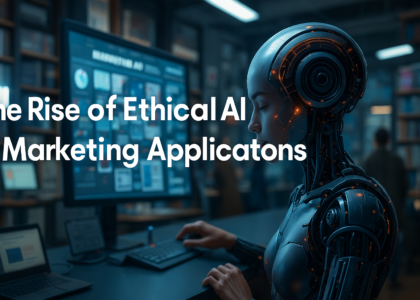Introduction to AI in Consumer Behavior Analysis
Over the past decade, consumer behavior analysis has transformed from intuition-based guesswork to data-driven precision. This evolution has been accelerated by the rise of artificial intelligence (AI), which provides businesses with the ability to process vast amounts of consumer data and derive actionable insights. Today, AI is not just enhancing consumer analysis—it’s revolutionizing it.
By leveraging algorithms, machine learning models, and advanced data processing techniques, companies can now predict consumer actions before they happen, enabling hyper-personalized marketing strategies and improved customer experiences.
What is Consumer Behavior and Why It Matters
Consumer behavior refers to the decision-making processes and actions individuals take when purchasing products or services. It is influenced by psychological, social, cultural, and economic factors. Understanding this behavior allows businesses to tailor their offerings, messaging, and customer service to better meet consumer needs.
Predicting consumer behavior plays a pivotal role in strategic planning. Accurate forecasts enable marketers to allocate budgets efficiently, anticipate market trends, and optimize inventory management—leading to increased profitability and customer satisfaction.

How AI Enhances Consumer Insight
AI brings a new level of depth to consumer insight through its ability to process and analyze massive datasets at scale. Traditional analytics rely on historical data and predefined rules, whereas AI-powered solutions use machine learning algorithms to detect patterns, adapt to changes, and make real-time predictions.
Natural Language Processing (NLP) also allows AI systems to analyze customer reviews, social media sentiment, and call center transcripts to extract insights about customer preferences, pain points, and expectations—something traditional systems struggle to accomplish at scale.
Key AI-Powered Tools for Consumer Behavior Prediction
Several industry-leading tools help businesses leverage AI for consumer insights:
- Google Cloud AI and BigQuery: This combination allows companies to manage and analyze terabytes of consumer data while applying machine learning models for predictive insights.
- IBM Watson Customer Experience Analytics: Offers customer journey visualization, behavior pattern recognition, and deep segmentation to help companies refine user experiences.
- Adobe Sensei: Integrates AI into Adobe’s suite, enabling real-time personalization, automated content creation, and dynamic customer segmentation.
Data Collection and Processing in AI Systems
For AI to function effectively, it must be fed quality data. Sources of consumer data include purchase history, web and app behavior, CRM systems, loyalty programs, and even social media interactions.
Before analysis, this raw data undergoes preprocessing—cleaning, normalization, and transformation into machine-readable formats. Feature engineering then identifies the most relevant data points for model training, enhancing prediction accuracy.

Predictive Modeling Techniques in Consumer Analytics
AI uses several types of predictive modeling to interpret and forecast consumer behavior:
- Classification Models: Predict categorical outcomes such as “will purchase” or “will churn.”
- Regression Models: Estimate numerical outcomes like expected purchase amount.
- Clustering Models: Group consumers based on similarities in behavior or demographics.
Real-time behavior prediction is increasingly popular, allowing systems to personalize offers or recommend content dynamically as users interact with platforms.

Use Cases Across Industries
AI-powered consumer behavior prediction is transforming multiple sectors:
- Retail: Companies use AI to offer personalized product recommendations, predict demand, and adjust pricing dynamically.
- E-commerce: Platforms track user behavior to retarget customers who abandon carts and predict future purchases.
- Banking: Financial institutions use AI to detect potential customer churn, prevent fraud, and recommend financial products.

Benefits of Using AI to Predict Consumer Behavior
Adopting AI-driven consumer analysis delivers multiple advantages:
- Enhanced Customer Engagement: Personalized experiences foster deeper customer relationships.
- Higher ROI on Marketing Campaigns: Better targeting ensures more effective ad spending.
- Improved Customer Satisfaction: Anticipating needs boosts loyalty and retention.

Ethical Considerations and Data Privacy Concerns
While AI offers immense potential, it raises important ethical questions:
- Transparency: Businesses must explain how AI models make decisions that affect customers.
- Privacy: Compliance with regulations like the GDPR and CCPA is essential to protect consumer data and build trust.
Ensuring AI use aligns with ethical standards helps brands avoid reputational damage and legal complications.
Challenges in Implementing AI for Consumer Behavior
Despite its benefits, implementing AI is not without obstacles:
- Data Quality and Availability: Poor data leads to poor predictions.
- Technical Barriers: High costs, complex integrations, and a lack of skilled professionals can slow adoption.
- Organizational Resistance: Cultural shifts and internal buy-in are critical for AI success.

Future Trends in AI and Consumer Behavior Prediction
Looking ahead, several trends are shaping the future of AI in this field:
- Integration with IoT and Edge Computing: Real-time data from smart devices enhances prediction accuracy.
- Hyper-Personalization: AI will increasingly enable content and product personalization at the individual level, even in real time.
- Voice and Conversational AI: Customer interactions via voice assistants and chatbots will fuel deeper behavioral insights.

Steps to Integrate AI Tools in Your Marketing Strategy
To begin leveraging AI for consumer predictions, follow these steps:
- Evaluate Business Needs: Define clear goals for what you want to achieve with AI.
- Choose the Right Tools: Consider your budget, data infrastructure, and integration capabilities.
- Align Teams: Ensure marketing, IT, and leadership are on the same page.
- Train Staff: Equip your team with the skills needed to use AI tools effectively.
Case Studies and Real-World Success Stories
- Amazon: Uses AI for product recommendations, dynamic pricing, and inventory forecasting—contributing significantly to its market dominance.
- Netflix: Leverages viewing behavior data to offer highly personalized content recommendations.
- Spotify: Uses AI to curate playlists based on listening history and emotional tone.
Even small businesses are adopting AI with platforms like HubSpot and Zoho, proving that AI adoption isn’t just for tech giants.
Conclusion
AI-powered tools are revolutionizing how businesses understand and predict consumer behavior. From personalized marketing to fraud detection, AI is offering actionable insights that were once unimaginable. As data becomes more abundant and technology more accessible, companies that embrace AI will be better positioned to meet customer expectations and outperform competitors.
Whether you’re running a startup or managing a large enterprise, now is the time to explore AI’s transformative potential in predicting consumer behavior.





